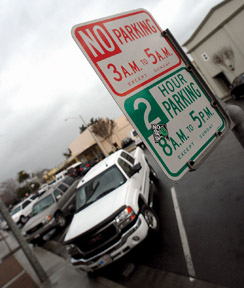Hollister City Council to consider proposal to bring back
enforcement of timed spaces
In response to complaints that parking spaces are being used all
day by employees of offices in downtown Hollister, the city council
this week supported the idea of bringing back the parking
enforcement program suspended by police nearly five years ago.
Hollister City Council to consider proposal to bring back enforcement of timed spaces
In response to complaints that parking spaces are being used all day by employees of offices in downtown Hollister, the city council this week supported the idea of bringing back the parking enforcement program suspended by police nearly five years ago.
A specific proposal is expected to come up for a vote next month.
“Some business owners, particularly retailers, have complained that parking spaces in front of retail stores are being monopolized by clients of downtown offices, and, in particular, employees of those same offices,” Police Chief Jeff Miller said in a report to the council.
Since regular downtown parking enforcement hasn’t been done for years, people have been parking for hours, if not all day, in spaces designated as two-hour spots. Police have continued to issue citations for red zone or handicapped space violations, Miller said.
“It was felt that increased turnover in parking areas will improve customer convenience and will contribute to greater economic viability of downtown businesses,” he said.
It is expected that enforcement would be conducted four hours per day, according to Miller, though exactly which four hours has yet to be determined.
Councilman Victor Gomez said he and his colleagues are in favor of reinstating timed parking enforcement downtown as long as it’s at least “revenue neutral.”
“We want it to be self-sufficient,” he said. “We don’t want it to be another debt for the city. Altogether, this position will cost us roughly $30,000 a year. We’re anticipating bringing in about that much through the citation process.”
Gomez said the council directed the police chief to look for a parking enforcement vehicle that is cheaper than Miller’s $35,000 estimate, and they asked for a proposal to bring the current $20 citation fee more in line with other area cities that charge in the $30 range. The item is expected to come back before the council at its second meeting in March.
Brenda Weatherly, executive director of the Hollister Downtown Association, said an influx of service-related businesses and a decrease in the number of retail stores in and around San Benito Street has meant more employees are parking from 8 a.m. to 5 p.m. in spaces designed for two-hour turnover.
“It’s really difficult for downtown businesses when they can’t provide their customers with parking that is fairly close to their store,” she said. “One parking space is worth thousands of dollars of business. People don’t think about that when they’re parking in front of their store or a neighbor’s store” for longer than two hours.”
In a September letter to the City Council, HDA President Yvonne Caporgno said downtown parking “has become more difficult than ever.”
“Abuse of these two-hour parking areas has become rampant,” she said. “Unfortunately, the rules have largely been ignored by the people and businesses that would benefit most from the enforcement of these parking regulations.”
Jerry Muenzer, chairman of the HDA’s economic restructuring committee and owner of Muenzer’s sporting goods store on Fifth Street, said he has been pushing the city to reinstate downtown parking enforcement for more than a year.
“The lack of enforcement is killing us,” he said. “We hear every day how customers are complaining how there is no parking in front of our store or in the lot in the back. It’s been bad all the time that there’s been no enforcement.”
Hollister’s parking enforcement officer was let go in June 2004 during a round of layoffs, about six months after the police department last regularly enforced time restrictions on downtown parking.
In the spring of 2004, the city council voted to extend the two-hour downtown limits in six city-owned parking lots to four hours, then reversed course after complaints from some businesses.
Around that same time, city officials reversed course on the planned purchase of a $30,000 parking enforcement vehicle, which was deemed an unnecessary expenditure during tough budget times.
Chief Miller said he agrees with the council’s direction to make the parking enforcement program revenue-neutral, as writing tickets to raise money also raises ethical questions.
“When it comes to any type of citations – parking or moving – I don’t believe in citations for the purpose of generating revenue,” he said. “We do enforcement for the specific goal of compliance. We want people to park to the time allowed, then move to allow someone else to park there.”
Sheila Stevens, owner of She’s and the Knife and Fork Cafe on San Benito Street, said she is not in favor of bringing back the parking enforcement downtown.
“Usually I don’t mind it, but give us a break here,” she said. “We’re trying to get people to come downtown.”
With the recent opening of the Hwy. 25 bypass, Stevens said downtown businesses should be given some time to see what impact the diverting of some traffic will have on the area.
“I’m not against the bypass, we just need to encourage people to come downtown,” she said, noting that would be less likely if people are worried about getting tickets. “At least give us a few months. I want to encourage the people that do come downtown to be able to park freely for awhile.”
The HDA has worked to educate downtown business owners and their employees about the importance of not taking up valuable parking spaces, Weatherly said.
“The enforcement needs to happen first,” she said. “You can educate people about the value of a parking space, but unless there’s a reason to move, it’s an inconvenience to do so.”
Downtown officials have discussed creating incentives for business people to park elsewhere, reevaluating where city-owned lots are located and perhaps privatizing some spaces, Weatherly said.
“We’ve got a parking garage [at the corner of Fourth and San Benito streets] and plenty of parking on East and Monterey streets,” she said. “The lots are all two-hour lots, but in fact they’re all 24-hour lots now.”
In the wake of the bypass opening, the HDA’s economic restructuring committee is hoping to begin discussions about how to alter the feel of downtown after the state hands back control of San Benito Street to the city, approximately one year from now.
“It may change the whole feel of downtown when we get [the street] back,” Weatherly said. “We could do crosswalks; the city could decide to reconfigure traffic on the street; we can create more pedestrian pathways” and angled parking – as is present on downtown side streets – is a possibility.









